Display
The 4.8" HD Super AMOLED display would've been really exciting a year or two ago, but these days IPS and advanced LCDs offer sharper text, wider viewing angles and better outdoor visibility. We'd love to see Samsung move away from Super AMOLED displays in their most expensive phones; they once were a competitive advantage but now hobble the phone. The 1280 x 720 display has a Pentile Matrix that uses fewer subpixels than LCDs, and the result is slightly reduced sharpness. Still, there are a lot of pixels here thanks to the high resolution, and we suspect many Super AMOLED fans will enjoy the display. Super AMOLED displays have better than life colors, though the colors are more in control here and less cartoony, and black levels are phenomenal. White levels are Super AMOLED's weak spot and whites aren't quite as bright as LCDs and they still have a slight blue tint, despite the GS3's improved color balance. The display's colors pop, but the screen isn't hugely bright. Note that Samsung has a power saving feature that automatically dims whites to save power and we suggest turning this off to avoid dingy whites (the power drain is negligible).
Samsung's auto-brightness as ever tends to be too dark, so we had to go with manual brightness to suit our eyes. I don't mind manual brightness but that means having to adjust it when outdoors under sunlight because the display is hard to see at 50% brightness (my preferred indoor brightness setting).
Phone and Data
The Samsung Galaxy S III has superb voice quality on both Sprint and T-Mobile. Samsung really knows how to make an excellent voice phone. Incoming and outgoing voice are loud and very clear with no background noise or digital distortion. Just in case call quality isn't already stellar enough for you, there's a volume boost setting for noisy environments and EQ settings-- yes EQ isn't just for music players anymore.
On both the T-Mobile and Sprint versions our data connection sometimes dropped for a second every so often. That makes me think there's a firmware issue since it occurs on two different carriers, and I'd assume Samsung could fix this with an update if it proves to be a problem for others.
The T-Mobile version has 42Mbps HSPA+, and that provides excellent data speeds that didn't make me pine for LTE. Our phone averaged 11Mbps down and 1.5Mbps up. The Sprint version has 3G EV-DO Rev A and 4G LTE, but Sprint's LTE network isn't yet live, so we had to use their sluggish 3G network that averaged 400k down and 350k up in our area of the Dallas metroplex. Sprint's version has a feature that will automatically turn WiFi on if the phone is in range of a known WiFi network and that certainly helps. AT&T and Verizon versions have both 3G and LTE, and both carriers have robust LTE networks with fast data speeds. All carrier versions have the mobile hotspot feature that turns your phone into a high speed wireless modem for laptops, tablets and other devices (this may require an additional monthly charge).
Performance and Battery Life
All US carriers are going with the 1.5GHZ dual core Snapdragon S4 CPU (because it's compatible with LTE) rather than Samsung's latest Exynos CPU. That's not a bad thing since the Snapdragon S4 is a top performer that holds its own against the Exynos and quad core Tegra 3. It manages strong battery life as well, and the Galaxy S III on T-Mobile and Sprint (neither running on LTE) had no trouble making it through a full day on a charge with moderate use. When we get our hands on the LTE Verizon and AT&T models, we'll update this review with info on their battery life.
The Galaxy S III benchmarks similarly to other 1.5GHz Qualcomm S4 smartphones like the HTC One X. It falls just a few points behind the One X, and it feels responsive despite the demands of TouchWiz 4. Is it one of the fastest Android phones currently on the market? Yes it is. Does it feel faster than the iPhone 4S? Not so much, but that's an Android vs. iOS issue. The phone has Adreno 225 graphics, and that's a capable graphics processor that can handle the latest 3D titles well. We tested a variety of games that worked perfectly, though Max Payne didn't draw on screen controls on the GS III, making it impossible to play. That seems to be a compatibility issue with some Samsung models and the developer is working on that issue.
Benchmarks
*Note that the Sprint and T-Mobile versions benchmarked identically with a less than 15 point difference in Quadrant and AnTuTu.
Software
The smartphone runs Android OS 4.0, the latest and greatest version of that OS. It has Samsung TouchWiz 4, and if you're a Samsung owner, the UI will look very familiar to you. In fact, it really doesn't resemble vanilla Android at all, and Samsung goes farther than HTC's Sense to skin Android (watch our video review to see TouchWiz in detail). You get Samsung's usual custom app icons, their widgets for various Samsung apps and services like Media Hub, S Memo, S Calendar (it now skins Calendar instead of being a separate app) and Samsung's music and video players as well as a host of new widgets. There are many, many screens of widgets to choose from out of the box. Samsung's own app store is on board, as is their Buddy Photo Share feature, AllShare Play DLNA streaming, a wireless group PowerPoint presentation feature, and a proprietary Galaxy S III to Galaxy S III hybridization of Android Beam NFC and WiFi Direct called S Beam. Honestly, there's more software here than most of us can wrap our heads around. Samsung's software push is perhaps excessive: some of the apps and features feel more like buried gee-whiz gimmicks than stuff that's easy to use and necessary. That said, you can explore what you wish and ignore the rest.
The most talked about feature is Samsung's S Voice. It's Vlingo on steroids and it tries to fight Siri on the iPhone but loses. Where Siri does a pretty good job of hearing and understanding us, S Voice seems like my partially deaf grandma from the old country whose English is a little quirky. It helps if you talk quite loudly at the phone when issuing commands, and forget using it in noisy environments. Like Siri, it sends your commands to a server using the data connection and the server interprets those commands and tells the phone what to do. If your data / WiFi connection is slow or down, you'll get "sorry, network connection error" messages. Check out our video review to see S Voice in action. It is useful for most common tasks like checking the weather or your next appointment, but it doesn't do well with those fanciful natural language queries that Siri handles so well like "what's the meaning of life?"
You can set the phone to always listen for your command (prefaced with something like "hi Galaxy"), and that can impact battery life. Alternatively, you can set it to run whenever you double-press on the home button, which doesn't affect battery life.
One of our favorite features is how the phone will automatically call the person you're currently texting if you put the phone to your head when viewing that conversation. And we really like the Smart Stay feature that uses the front camera to see if you're looking at the phone's screen and prevents it from turning off while you're looking at it (but why isn't this feature turned on by default?). Less useful but cool if you want to impress your friends is the PIP (picture in a picture) feature where you can play a video in the Samsung video player and tap a button to keep that video running in a small window while you're in other apps.
Camera
Like the Galaxy S II, the S III has an 8 megapixel camera that can shoot 1080p video, but quality has improved over the S II. We still noted some exposure issues in bright outdoor shots where the camera rendered hazy images, but the new HDR feature helps greatly with that. Dedicated image processing chips are the next big thing in high end phones (the HTC One X has one too), and that allows for extremely quick shot times. Again, like the HTC One X and One S, you can shoot photos while simultaneously recording video but there's no slow motion option like that of the One X. There are plenty of effects to play with: exposure, macro mode, face detection, smile detection and panorama. This is a very capable camera, though we give the edge to the HTC One X for image quality.
Video quality is excellent at 1080p and 30fps: video is sharp and colorful with smooth motion and little in the way of blockiness. The continuous autofocus sometimes hunts when several subjects are in motion at once, but overall it's great stuff.
For those of you who can't be social enough, there's Share Shot: a feature where you and your GS III-toting buddies can share photos in real time over a WiFi Direct connection. Speaking of social, Buddy Photo Share will implore you to tag faces and assign photos to your social networking friends. This was a hit or miss feature and it sometimes didn't recognize nearly identical shots of the same person, and it thought a houseplant was my best friend.
Conclusion
Is the Samsung Galaxy S III an excellent smartphone? Yes it is. Given the millions of preorders, I suspect many of you would buy this no matter what I said about the phone. That speaks of Samsung's momentum in the smartphone market and their excellent track record. Is this Samsung's best Android phone ever? Yes it is, but there is room for improvement. I'd love to see Samsung use high quality materials and cutting edge designs in their top tier phone. I wish they'd cut down on the absurd number of features and apps introduced with the GS III, and instead focused on making a few core apps really solid. S Voice is a fantastic feature that needs more development (it's hard of hearing, prone to network connection errors and needs more natural language AI to compete with Siri). With more work, it could really sell folks on the Galaxy S III. If Samsung axed the Group Cast PowerPoint presentation sharing over WiFi feature to spend more time on S Voice and facial recognition in photos, the smartphone world would be a better place. Software and cosmetic gripes aside, the Samsung Galaxy S III has phenomenal voice quality, a fast CPU and good battery life for a powerful phone. If you buy one, you probably won't be disappointed.
Price: Starting at $199 for 16 gig model with contract
Website: www.samsung.com |

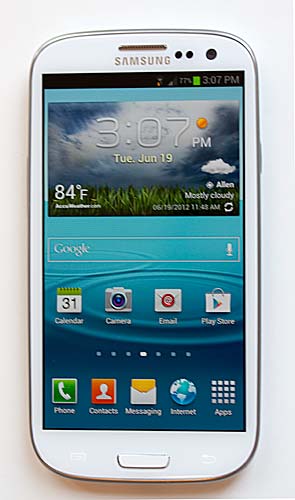
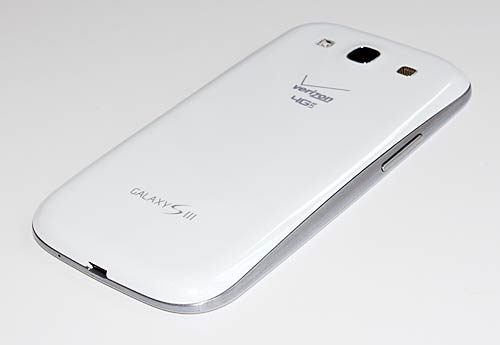
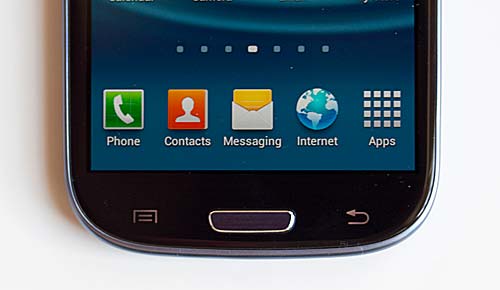
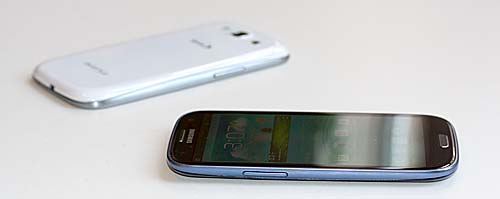
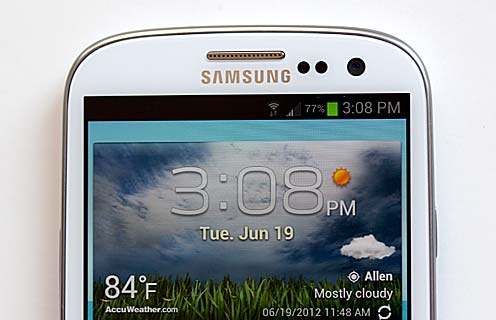
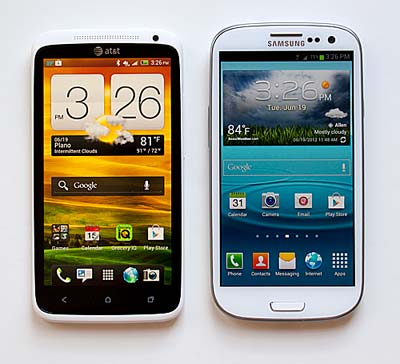
Directly above: the HTC One X and Samsung Galaxy S III. |

